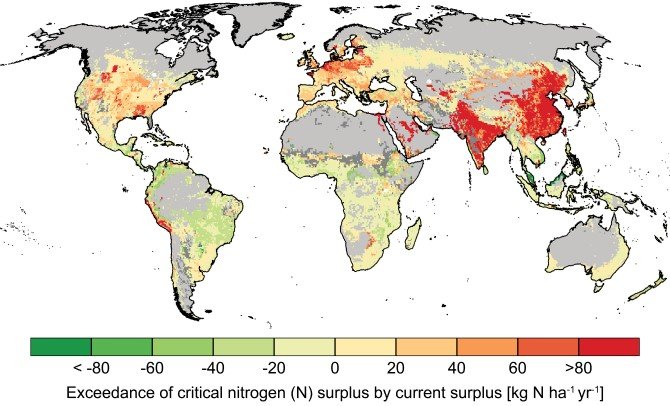
News
Nitrogen boundaries exceeded in many world regions
It has long been known that humanity is exceeding planetary boundaries for nitrogen use. Scientists have now mapped those exceedances regionally for the first time. Whereas countries in north-western Europe and parts of India and China are emitting far too much nitrogen, there is actually room for intensification of nitrogen use across much of Africa and South America. The research was published today in the scientific journal Nature.
In 2009, Nature published an opinion article introducing the concept of planetary (global) boundaries. In the article scientists identified nine boundaries within which humanity must navigate to ensure the stability of the Earth system, including climate change, biodiversity decline and nitrogen inputs.
Six years later, an article in Science based on new data concluded that three of these boundaries, including the threshold for nitrogen, have been exceeded. However, those estimates did not take into account regional differences in the sensitivity of ecosystems to nitrogen pollution and in nitrogen losses from agriculture and other sources.
Distributing better across world
In this new study, the scientists compared regional nitrogen surpluses and losses with regional limits for effects on nature and water quality, such as decrease in biodiversity, degradation of drinking water quality and algal bloom in surface water. This shows that nitrogen is a many-headed monster: "There are large regional differences both in the degree of exceedance and in the type of problems caused by nitrogen," says Dr. Lena Schulte-Uebbing, lead author of the study, "In some regions the limits for water quality are exceeded, in others the limits for effects on terrestrial nature, and yet in others all of them are exceeded."

High exceedances in Europe and China, among others, contrast with underutilization in many countries in Southeast Asia, South America and Africa, where more nitrogen is needed for food production. In these regions, low fertilization leads to depletion of soil nutrient pools, causing soil degradation to a point where, in extreme cases, soils become unsuitable for food production.
More efficient nitrogen use
"Changing the global distribution of nitrogen inputs is important," says co-author Prof. Dr. Wim de Vries, "but even under optimal spatial allocation of nitrogen fertilization, the global boundary for nitrogen is still exceeded at current nitrogen use efficiency. To feed the world without exceeding regional and planetary nitrogen thresholds, we need to use nitrogen in agriculture much more efficiently. And in addition, we need to reduce emissions from non-agricultural nitrogen sources such as sewage or industry. Doing this effectively requires coordination."
The study was conducted by a team of researchers from Wageningen University, Utrecht University and PBL Netherlands Environmental Assessment Agency. The article was published in Nature on 19 October 2022.